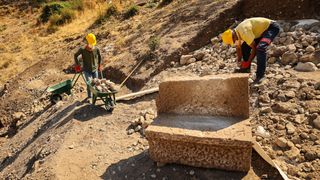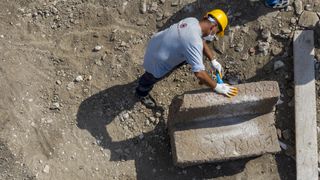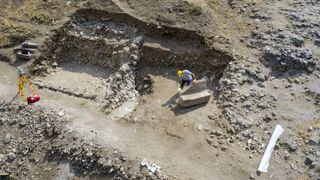'Box seats' found at Roman Empire-era arena in Turkey
It was probably a great way to watch a gladiator fight.

Archaeologists in western Turkey have discovered the 1,800-year-old equivalent of "box seats" at a giant arena dating to the Roman Empire.
During excavations at the ancient amphitheater of Pergamon, a large arena built to mirror the Colosseum of ancient Rome, researchers discovered two seat blocks with carved inscriptions on the arena's east side, according to a blog post by the Transformation of the Pergamon Micro-Region (TransPergMikro), the project behind the excavation, which is being funded by the German Research Foundation.
All segments of society attended the arena's events, but these VIP inscriptions suggest that elite families "had private seats in special sections with their names engraved on them," Felix Pirson, director of the Istanbul branch of the German Archaeological Institute, told Anadolu Agency, a Turkish state-run news organization. The German Archaeological Institute is one of several German and Turkish organizations carrying out the excavation.
Related: Image gallery: Combat sports in ancient Rome
The amphitheater of Pergamon is known for its unique setup; it was constructed "between a mountain slope and the western slope of a hill" when the region was part of the Roman Empire, according to TransPergMikro. "Since this building was built between two slopes, separated by a stream, which is transmitted via a vaulted water channel, it can be assumed that in the arena Naumachia (naval combat) or water games could be performed," TransPergMikro noted.
Gladiator fights also attracted an audience at the arena during the second century, according to Anadolu Agency. At least 25,000 spectators, and possibly as many as 50,000 people, could fit there, Pirson noted.

It's one of the best-preserved amphitheaters in Asia Minor today, but there has never been a detailed, accurate study published on it, which is why excavations are now being carried out by TransPergMikro archaeologists as well as the German Archeological Institute and Technical University of Berlin's Institute of Architecture, with the permission of Turkey's Culture and Tourism Ministry.
Sign up for the Live Science daily newsletter now
Get the world’s most fascinating discoveries delivered straight to your inbox.

Their hard work is paying off — the "box seats" hadn't been documented until now. "This discovery indicates that inscribed seat blocks for privileged individuals could be found not just in the ima cavea [lower seats] but also on upper levels," the archaeologists wrote in the post.
"Another detail that caught our attention was that Latin names were written in Greek letters," Pirson said. "We believe that some people from Italy had a special place in the Pergamon amphitheater."
The team excavated the seats and analyzed them with 3D photogrammetry, a technique that involves taking multiple detailed photos of an object from many angles to create an accurate 3D digital image.
The blocks are now on display at the Red Basilica courtyard, a ruined temple from ancient Pergamon, in the Turkish town of Bergama.
Originally published on Live Science.

Laura is the archaeology and Life's Little Mysteries editor at Live Science. She also reports on general science, including paleontology. Her work has appeared in The New York Times, Scholastic, Popular Science and Spectrum, a site on autism research. She has won multiple awards from the Society of Professional Journalists and the Washington Newspaper Publishers Association for her reporting at a weekly newspaper near Seattle. Laura holds a bachelor's degree in English literature and psychology from Washington University in St. Louis and a master's degree in science writing from NYU.
Most Popular

